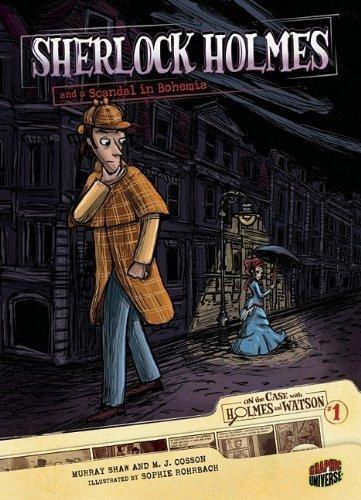Full Product Details
Author: Murray Shaw ,
Sophie Rohrbach ,
M.J. Cosson
Publisher: Lerner Publishing Group
Imprint: Graphic Universe
Volume: 01
Dimensions:
Width: 17.40cm
, Height: 0.70cm
, Length: 24.30cm
Weight: 0.274kg
ISBN: 9780761361855
ISBN 10: 0761361855
Pages: 48
Publication Date: 01 August 2010
Recommended Age: From 9 to 10 years
Audience:
General/trade
,
Children/juvenile
,
General
,
Children / Juvenile
Format: Hardback
Publisher's Status: Out of Stock Indefinitely
Availability: In Print

Limited stock is available. It will be ordered for you and shipped pending supplier's limited stock.
Reviews
"""These graphic novel–style adaptations of Holmes's adventures are well suited to middle graders. The dialogue is reminiscent of Conan Doyle's writing yet easier to follow. The illustrations' cartoon characters are appealing, but the heavy black lines and dark palette are sometimes intrusive."" --The Horn Book Guide * Journal * ""The On the Case with Holmes and Watson graphic-novel series opens with this spirited caper. The king of Bohemia hires the detective to locate a photograph of himself with the actress Irene Adler that he fears she will use to ruin his upcoming marriage to another woman. Holmes finds the photo all right but also finds a rare instance in which he gets truly outsmarted; forever after, he would admiringly refer to Adler as 'the woman.' A few spurts of action liven up the panels, which are otherwise mostly occupied by talking faces, and although Rohrbach's scratchy style is simplistic, it gives the characters plenty of personality (Holmes rolling his eyes as he sees through a client's thin ruse says more about the detective than pages of exposition could). This story is an inspired choice for a series opener not just because it was the first Holmes short story published (following two novels) but also because it establishes right off the bat something that may surprise readers: a fallible Holmes."" --Booklist * Journal * ""Adapting Holmes stories into comics is very challenging, which makes these books all the more impressive. Very little happens in a typical Holmes story: something goes wrong, the detectives interview a series of people, the hero sits around thinking, and eventually he confronts the culprit. Comics are a visual medium, and in the same way that readers of novels—in which it's perfectly all right to describe at length the thought processes of a brilliant detective—tend to enjoy detective stories better than moviegoers do, comics readers tend to want to see things moving…not smart people sitting in chairs and thinking deeply. Sophie Rohrbach's illustrations are cunningly designed to address this challenge. She moves the point of view around dramatically, zooming in on Watson, for example, when he finally figures out something Holmes realized an hour ago, or swiveling the perspective so that we fail to see the face of a suspect whose identity would eliminate the mystery. The creators also interject short bits of narration on Watson's notepad to maintain the sense that Watson is writing down these adventures shortly after he has experienced them. The result is a mystery that is always engaging, even when the action is mild."" --Teacher Librarian * Journal *"
These graphic novel-style adaptations of Holmes's adventures are well suited to middle graders. The dialogue is reminiscent of Conan Doyle's writing yet easier to follow. The illustrations' cartoon characters are appealing, but the heavy black lines and dark palette are sometimes intrusive. --The Horn Book Guide --Journal Adapting Holmes stories into comics is very challenging, which makes these books all the more impressive. Very little happens in a typical Holmes story: something goes wrong, the detectives interview a series of people, the hero sits around thinking, and eventually he confronts the culprit. Comics are a visual medium, and in the same way that readers of novels--in which it's perfectly all right to describe at length the thought processes of a brilliant detective--tend to enjoy detective stories better than moviegoers do, comics readers tend to want to see things moving...not smart people sitting in chairs and thinking deeply. Sophie Rohrbach's illustrations are cunningly designed to address this challenge. She moves the point of view around dramatically, zooming in on Watson, for example, when he finally figures out something Holmes realized an hour ago, or swiveling the perspective so that we fail to see the face of a suspect whose identity would eliminate the mystery. The creators also interject short bits of narration on Watson's notepad to maintain the sense that Watson is writing down these adventures shortly after he has experienced them. The result is a mystery that is always engaging, even when the action is mild. --Teacher Librarian --Journal The On the Case with Holmes and Watson graphic-novel series opens with this spirited caper. The king of Bohemia hires the detective to locate a photograph of himself with the actress Irene Adler that he fears she will use to ruin his upcoming marriage to another woman. Holmes finds the photo all right but also finds a rare instance in which he gets truly outsmarted; forever after, he would admiringly refer to Adler as 'the woman.' A few spurts of action liven up the panels, which are otherwise mostly occupied by talking faces, and although Rohrbach's scratchy style is simplistic, it gives the characters plenty of personality (Holmes rolling his eyes as he sees through a client's thin ruse says more about the detective than pages of exposition could). This story is an inspired choice for a series opener not just because it was the first Holmes short story published (following two novels) but also because it establishes right off the bat something that may surprise readers: a fallible Holmes. --Booklist --Journal
Author Information
Sir Arthur Conan Doyle was born on May 22, 1859. He became a doctor in 1882. When this career did not prove successful, Doyle started writing stories. In addition to the popular Sherlock Holmes short stories and novels, Doyle also wrote historical novels, romances, and plays.



